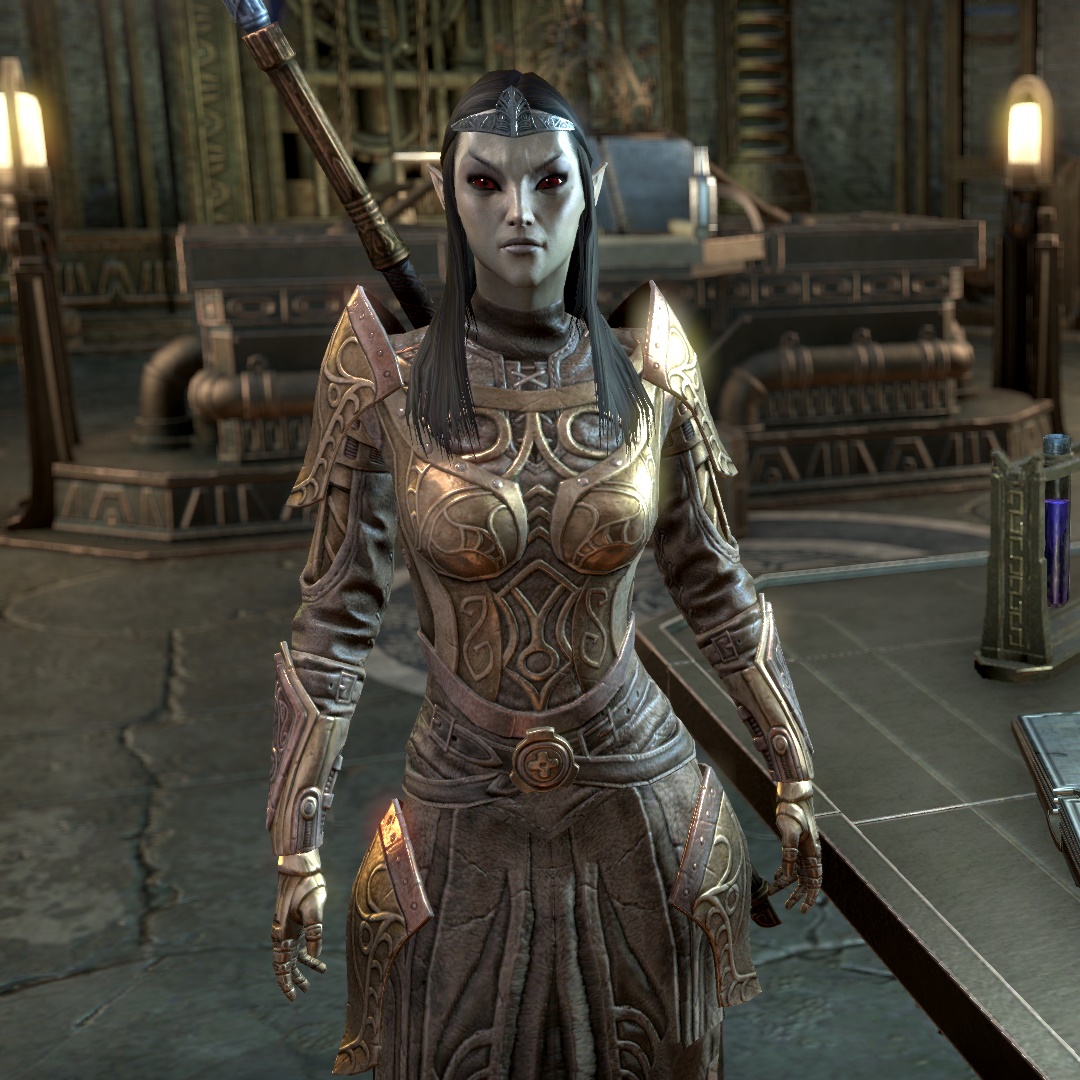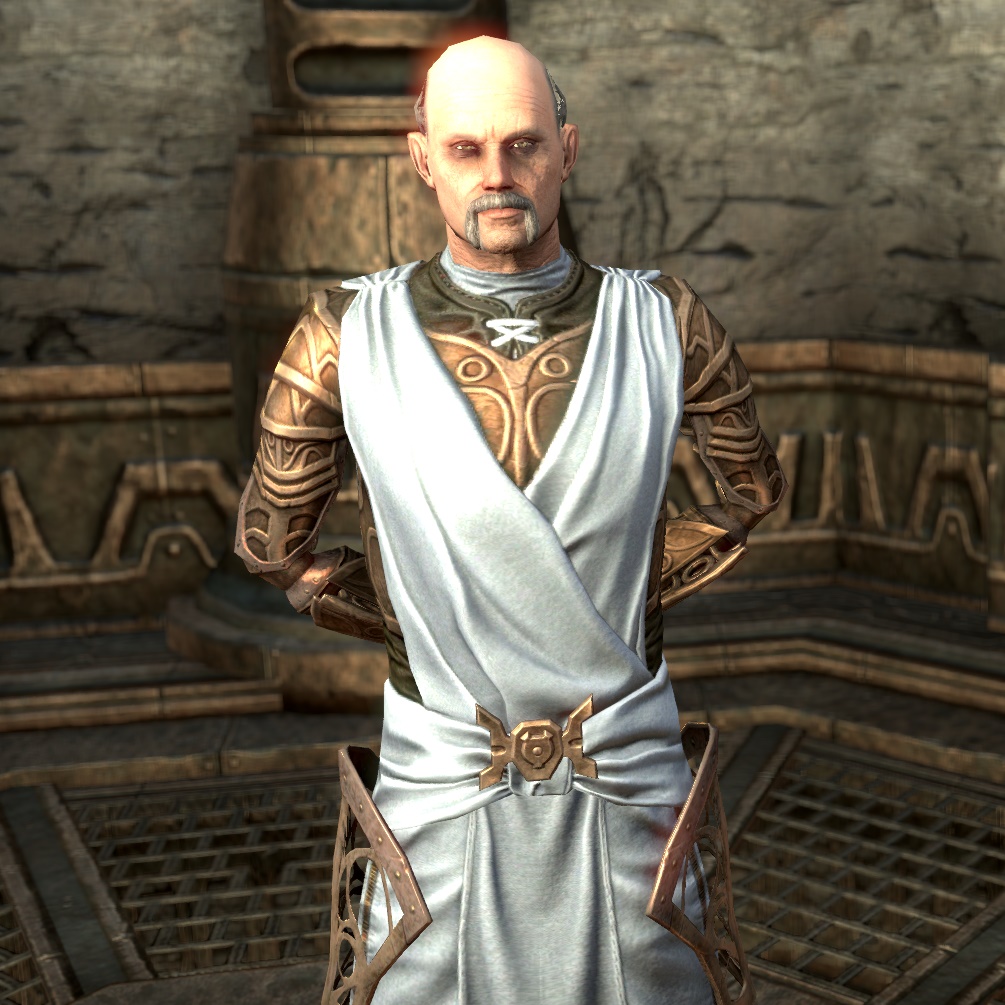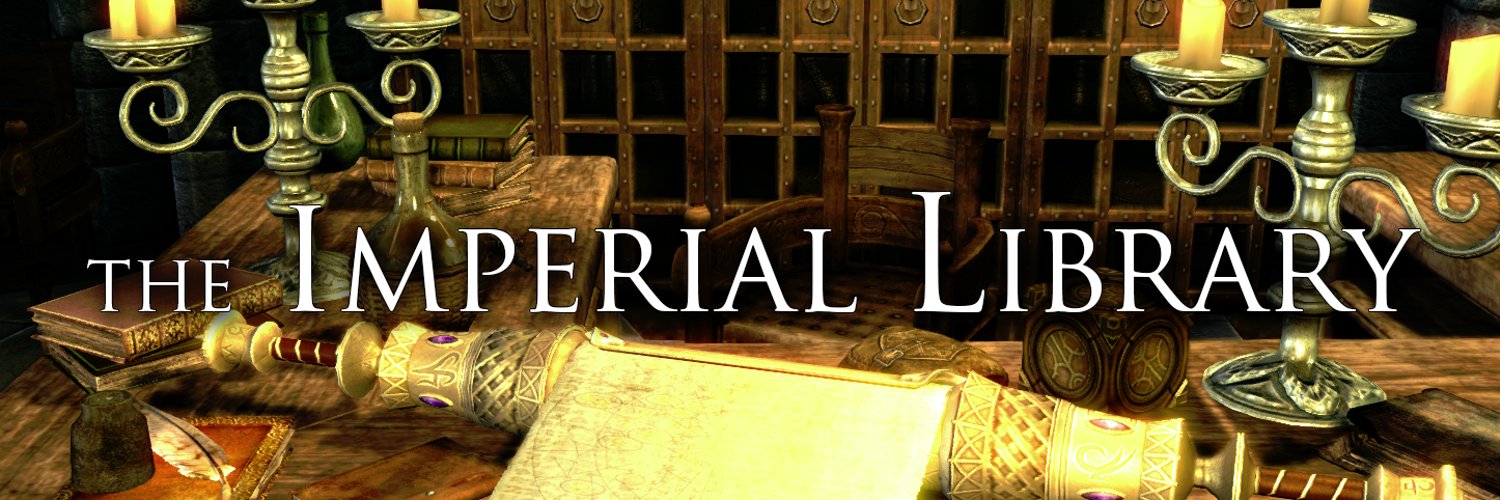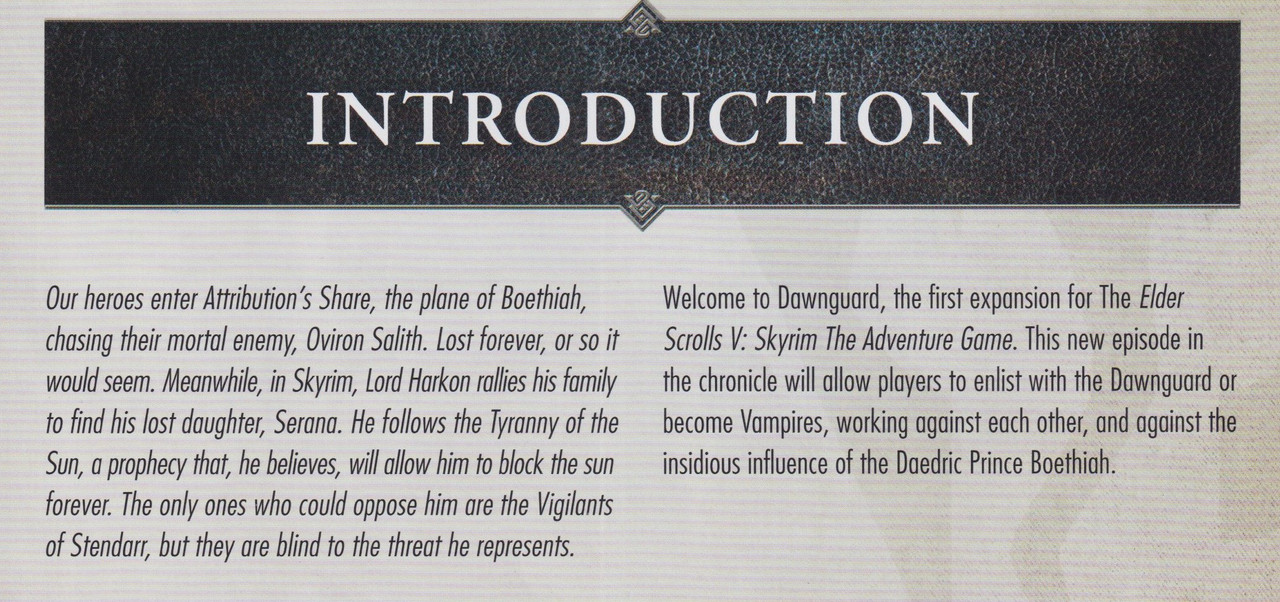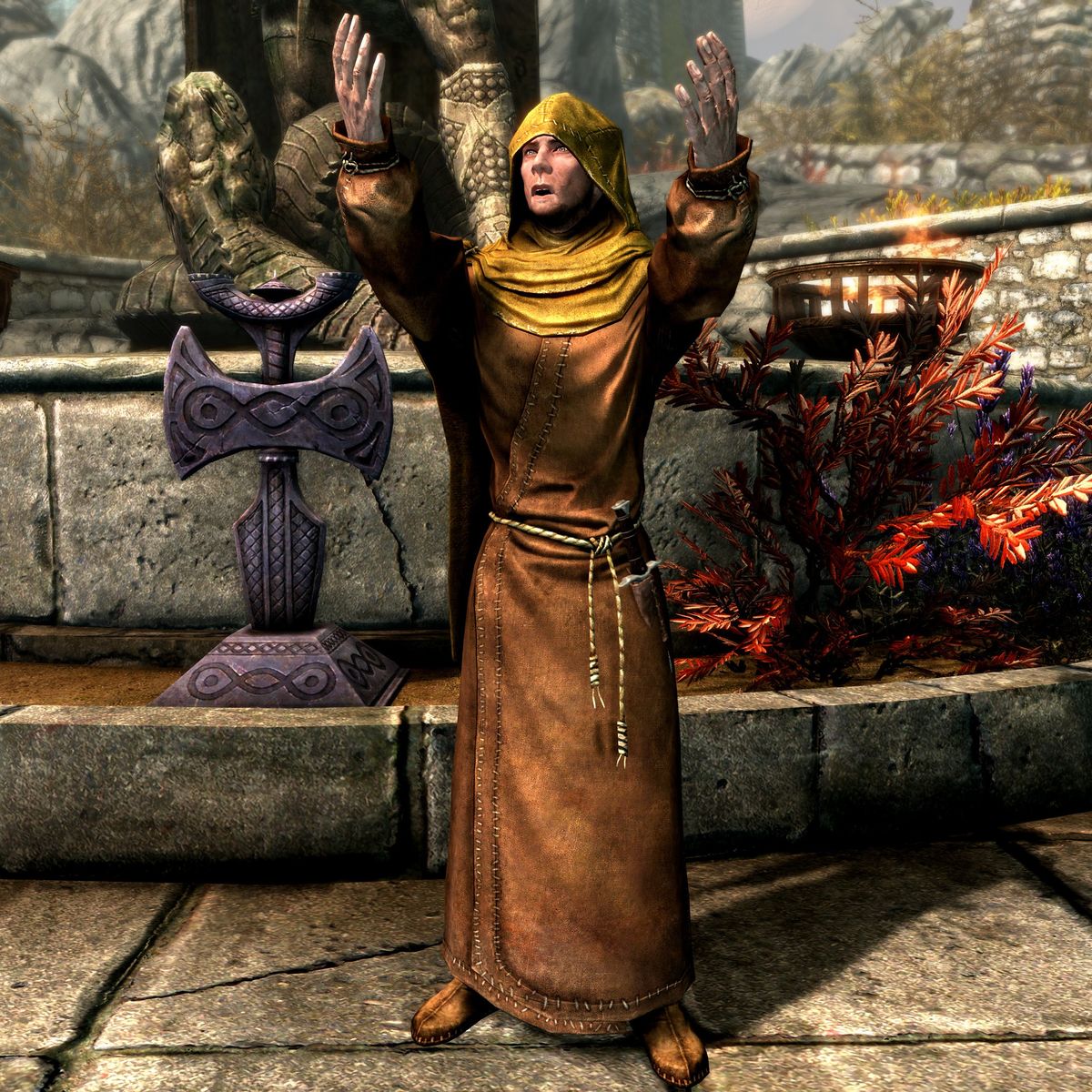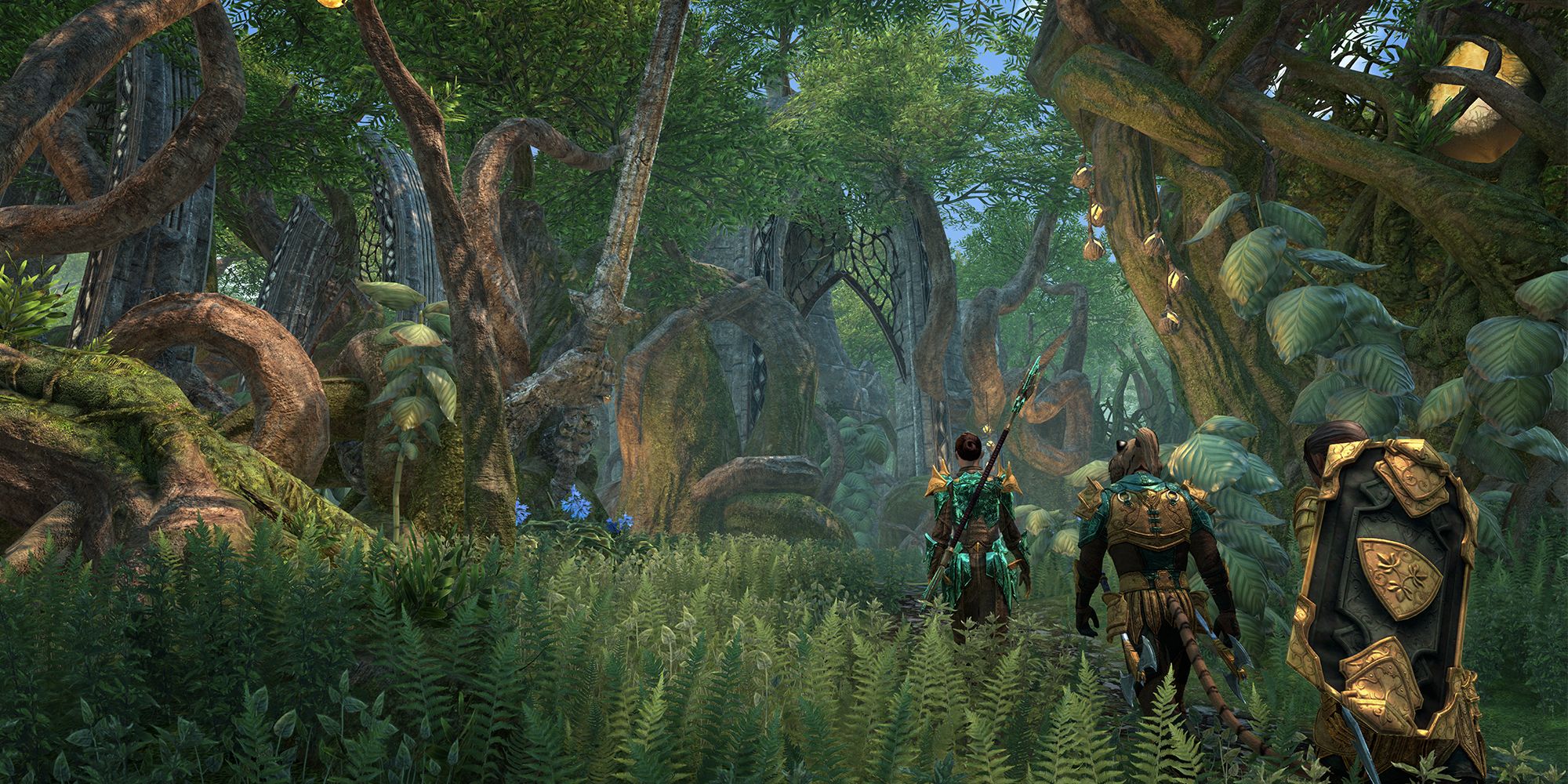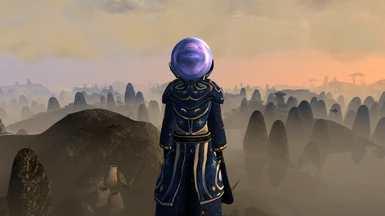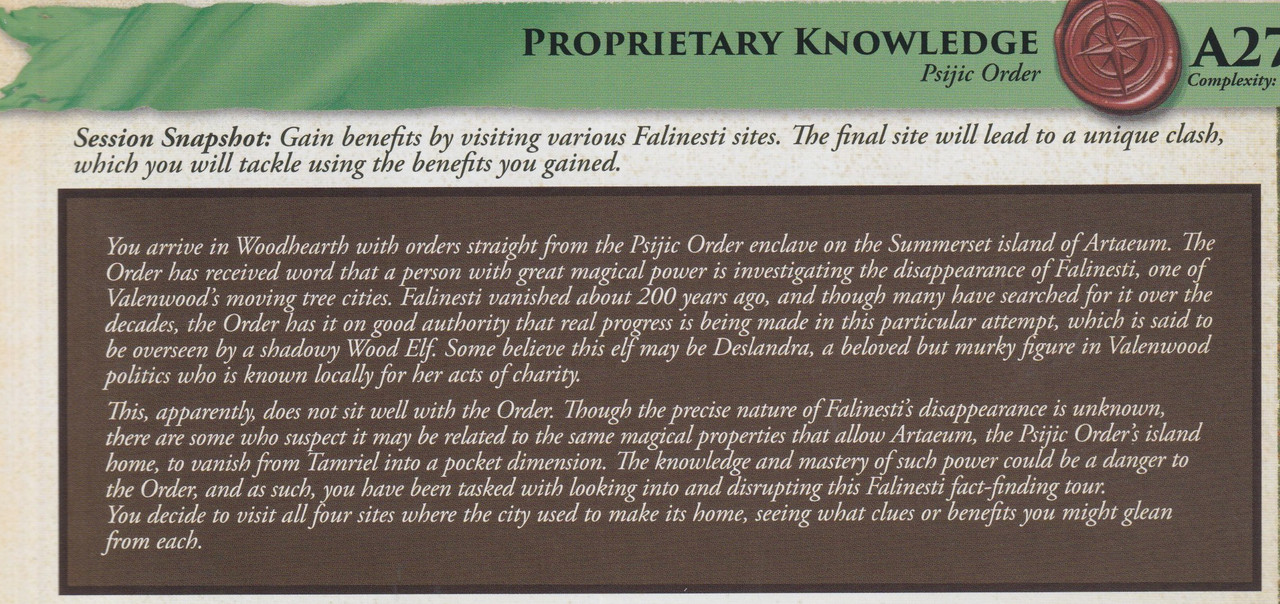A post I shall eventually post in my SB thread (when/if I should ever return there), countering the disrespectful dismissal of Kirkbride's works.
Many examples of Kirkbrides works being added into the games directly have been referenced many times across dozens of pages, but there are those who still insist that no one uses Kirkbrides stuff at Bethesda (or Zenimax). Clearly the sheer quantity of examples listing how his lore is used in the games directly isn't enough, so let's go for a different approach. Let's look at The Imperial Census of Daedra Lords, and OOG text written by Kirkbride and published on the Bethesda forums in 2006. I will post it all here...
Descriptions of the Daedra and their realms

www.imperial-library.info
Hey kids,
Still working on the sword-meeting, so in lieu of its presence and in honor of Propitiation Day, I give you “The Imperial Census of Daedra Lords” by the Imperial Geographic Survey. This version of the Census was written before Uriel VII’s demise, and is contemporary with the current Pocketguide.
Enjoy.
-MK
***
The Imperial Census of Daedra Lords
Azura, Lord of Dusk and Dawn, maintains the domain of Moonshadow, a twilight country of shades and half-thoughts. Visitors to this isle have historically come mainly from the Dunmer of eastern Morrowind and the catfolk of Elsweyr, whose people both hold a great affection for the mother of immanence, though by separate roads. At the time of this writing, regular gateways to Moonshadow have been inaccessible for the last several years. Whether this has to do with the unlawful incidents at Hogithum Hall in the Capital City or mere whim of Azura herself, no one can say. Of course, Azura’s most famous acts of recent times is the Incarnation of the Nerevarine, a subject that while far beyond the scope of this pamphlet has been felt to the present day.
Boethiah, the so-called Prince of Plots, has renamed his country of labyrinthine policy and betrayals yet again. Formerly “Snake Mount”, Prince Boethiah’s maze gardens and twisted towers is called “Attribution’s Share”, a realm best avoided by those that live outside the arcano-politic. Boethiah, like his cohort Azura, is much revered by the followers of the former Tribunal Temple, but sub-cults of his are entrenched in nearly every terrestrial seat of governance. His traditional festival date is the 2nd of Sun’s Dusk, when many contracts are writ between kings and commoners alike.
Clavicus Vile, child-god of the Morningstar, bestows a strange tranquility to his lands that seem concordant to his spheres of mockery and oath breaking, though what shape such concepts might take is admittedly unfathomable. Perhaps by rendering his domains as idyllic countryside the Prince exemplifies his greatest aspect, and that which ingratiates him to his many followers, the power of serenity through wish fulfillment. Only the strongest of the Emperor’s servants are advised to make covenant with Prince Clavicus, and even then are warned against sipping from the Bitter Cup.
Hermaeus Mora, “the Gardener of Men”, claims that he is one of the oldest Princes, born of thrown-away ideas used during the creation of mortality in the Mundus. Imperial Mananauts have verified that his influence on fate and time is real and unfeigned, implications of which tie this Prince directly with Akatosh, chief of the Nine Divines. Since Akatosh is the prime temporal spirit whose appearance led to the formation of the world, perhaps Hermaeus Mora speaks the truth. Nevertheless, it is the will of His Majesty Uriel VII that only on the official holiday of 5th First Seed should any propitiation to this Daedric Prince be delivered. “All else is mutation.”
Hircine’s Hunting Grounds have been closed by consensus of the Elder Council until further notice. It is mentioned here only for the sake of completeness.
Malacath holds the hardest to access of Oblivion’s extant lands, the Ashpit. As Prince Patron of the disenfranchised and cast out, it is only reasonable that the pathways to his domain take on a characteristic level of concealment. Orsinium, kingdom of the Orcs, gives Malacath its highest esteem, which is surprising when one considers the normal Orcish revilement of Daedric spirits. One might conjecture then that the rumors of Malacath not being a true Daedroth but an imprisoned aetherial spirit are true. It would certainly fit the Prince of Exile that he be one himself.
Mehrunes Dagon, Lord of Razors, has proven himself time and again the enemy of the Empire. Of terrible aspect and crowned in beaten copper, the four-armed Prince of Destruction has troubled the borders of the Mundus with warfare, foul rumor, and force of arms. Banished to dissolution during the Weir Gate massacre and again at Kvatch by battlemages of the 33rd, Mehrunes Dagon is returned to Oblivion once more, and the stars have foretold that his tenacity has known no forfeiture. All heroes of Cyrodiil are called upon to stand vigil against his hidden agencies.
Mephala’s domains in Oblivion are numerous and obscured, collected together by vast strands of magical ghostweb. All of them are devoted to her spheres of sex and secret murder. Echoing this same structure are the various esoteric cults devoted to her across Tamriel, many of which are forbidden by Imperial law. Her aspect is shrouded and manifold, even when she appears in the crowds that gather within her temples during Frost Fall.
Meridia’s holdings in Oblivion are collectively known as “The Colored Rooms”. Another Prince whose origins may not entirely be outside of the aetherial, Meridia has at several times been linked to Magnus the Sun. The most famous account of this association is the Tract of Merid-nunda, which overtly casts Meridia in the role of a wayward solar daughter, cast from the heavens for consorting with illicit spectra.
Molag Bal, King of Strife, is second only to his brother Prince Mehrunes Dagon in the enmity of our Emperor. His lands are the charnel houses the slave pens of Coldharbour, which hold no contrition for those travelers that visit them in error or purpose. That Molag Bal is allowed his holiday at all hearkens back to a treaty of ancient times, when he reputedly lent his infernal power to the creation of the first soulgems.
Namira’s Scuttling Void has been closed by consensus of the Elder Council until further notice. It is mentioned here only for the sake of completeness.
Nocturnal is accorded the title Ur-dra by nearly all the Royalty of Oblivion. As the mother of night, she claims to be an aspect of the original Void itself, and it is generally deemed best to fortify this declaration in one’s evening prayers.
Peryite’s pits have always been inaccessible to mortals. Our only real knowledge of them comes from reports of the other diabolical Princes. It is said that Peryite guards the lowest orders of Oblivion and that his summoners are to regard his likeness to Akatosh as some primordial and curious jest.
Sanguine, Prince of Hedonism, lords over no less than ten times ten thousand pleasure pockets of the Void. As revelry and drunken stupor fall under this Prince’s influence, he has been a favorite of many Emperors since the first foundation. Records even indicate that he resided in White-Gold Tower during the reign of Reman Cyrodiil and helped in the somewhat dubious draftsmanship of the Crendali Festivals, whose vulgarities did little to help Imperial expansion into Alinor and the other Summersets.
Sheogorath’s Asylums have been closed by consensus of the Elder Council until further notice. It is mentioned here only for the sake of completeness.
Vaernima, Prince of Omen and Dream, shares a special mageographic connection with the Mundus, since mortal sleepers often slip into her realm without any help at all. Traditional sacrifice to Vaernima is held on the 10th of Suns Height, but as with most luck spirits, prayers to this Daedric Prince occur quite frequently, and not always before bedtime.
While some of these realms are the same as in the games (Azura's Moonshadow) he names several others (and leaves others yet unnamed). Since this OOG was posted, there have been many other TES stories which delve into the realms of the Daedric Princes. So, if nobody uses Kirkbride's stuff, it stands to reason that they won't use whatever the names he gave to the realms.
Let's start with Meridia's realm, which features in the main story of ESO. To remind you of what Kirkbride wrote...
Meridia’s holdings in Oblivion are collectively known as “The Colored Rooms”. Another Prince whose origins may not entirely be outside of the aetherial, Meridia has at several times been linked to Magnus the Sun. The most famous account of this association is the Tract of Merid-nunda, which overtly casts Meridia in the role of a wayward solar daughter, cast from the heavens for consorting with illicit spectra.
Given Meridia's hatred of the undead and reverence for life, perhaps they'd have named it something like the Halls of Life, or the Lux Prisma to relate to her connection with light and the Magne Ge. Or maybe something simple like the Radiance. That's just throwing a few out there. There are so many names to choose from.
So what name did they end up going with? Remember, we are told that no one uses Kirkbride's OOG texts, so following through, the name they used will not be whatever he came up with, that being the Colored Rooms.
The name they went with was, of course, the Colored Rooms.

en.uesp.net
Meridia's many-faceted realm is known as the Colored Rooms. She is said to have formed it out of the chaos of Oblivion by an act of sheer divine will.
The above is a loading screen delivering the information via third person omniscient that Meridia's plane(s) of Oblivion is infact named the Colored Rooms. If this is not enough, then I shall remind you that visiting the Colored Rooms
is a required part of the main story of ESOs initial plot. Not some side quest, not even a major faction quest, but the main quest.
Curious too, is how the Colored Rooms and their nature (as is also implied its history) draws inspiration from the Imperial Census of Daedra Lords. More on the subject is discussed in the in-game book Exegesis of Merid-Nunda (a direct reference to the Tract of Merid-Nunda mentioned in the Imperial Census of Daedra Lords), which makes even further references to Kirkbride's works with reference to the Mnemoli.

en.uesp.net
"… were known as the Nine Coruscations, who followed the parabolas that led away from Magnus. Merid-Nunda was of these Sisters, as was Mnemo-Li, as was Xero-Lyg, as was …."
This appears to identify the "Daedric Prince" Meridia with the so-called Star-Orphans, those Anuic ur-entities that separated from Magnus when that Divine withdrew from the creation of the Aurbis. The best-known of these Star-Orphans is probably Mnemoli the Blue Star, who is associated with un-time events, and was said to be visible even in the daytime sky at the time of the Dragon Break.
On the nature of the realms, what of a Realm which Kirkbride didn't name but described the nature of? Returning once more to the Imperial Census of Daedra Lords, we see that the OOG text describes Sanguines domain as being composed of over 100,000 pocket realms.
Sanguine, Prince of Hedonism, lords over no less than ten times ten thousand pleasure pockets of the Void. As revelry and drunken stupor fall under this Prince’s influence, he has been a favorite of many Emperors since the first foundation. Records even indicate that he resided in White-Gold Tower during the reign of Reman Cyrodiil and helped in the somewhat dubious draftsmanship of the Crendali Festivals, whose vulgarities did little to help Imperial expansion into Alinor and the other Summersets.
Now, if we are to believe that Kirbride's work isn't used by anyone, then any reference to Sanguine's realms in any games would be something completely different, wouldn't it? After all, they would make something completely different, but still reflecting Sanguines nature. Something like a great giant realm of dark and decadant celebrations, perhaps split into lighter and darker indulgences like the Shivering Isles?
Well, we can find out the nature (and name) of Sanguine's Realm with the Loremaster's Archive...
“Greetings, Multiplier of Motions Known! I erect the spines of respect and honesty, respectively, that you may know I come to communicate with you in good faith. It wasn't easy for me to create a portal to your realm, running out of echkin fang you see, but after hearing you were accepting visitors I thought you wouldn't mind speaking to a warrior-scholar like myself over Daedric matters...especially one who used to be involved in such matters on a more personal level. I have also brought you a token, the sword of the fallen Redguard warrior Laja Saun, a follower of Hoodoc, the Yokudan God of Talks and Makes Others Listen and one of your ancient enemies, to ensure you that I hold no ill against you, m'lord. Now with all of the niceties out of the way, I have some questions I hope you would not mind answering.
For my first question, I would to know more about the procedures and hierarchy that revolves around the “ownership" of a pocket realm in the Second Void. If I recall correctly, only Daedra Lords, Demiprinces, and mortals of much prestige may possess a “permanent" personal realm of their own in the Oblivion. However, a majority of the pocket realms I have seen are actually isolated sections of what appears to be the “main realms," the domains of the Daedric Princes. Does this mean that the Princes, who by definition of their very beings are entities that crave absolute control of their spheres of influence, allow minor functionaries to have control over parts of their personal kingdoms? Or are these realms merely created by the Princes themselves for their distinguished subjects to use, but is in essence every part of their domain in all the ways that matter? This would explain how such Princes like Sanguine can have over a thousand personal realms to do as they see fit with, without governing over them themselves constantly by leaving those duties to trusted servants.“
- Eis Vuur Warden, Wayward and Contract Scholar
Lord Fa-Nuit-Hen says, “For a mortal, you make pretty good guesses, O scholar. Tutor Riparius, would you care to go into detail?"
Tutor Riparius says, “Certainly, Lord Demiprince! The catch-all term 'pocket realm' may apply to any minor plane of Oblivion, whether linked to the major plane of a Daedric Prince or not, that is, whether incorporated, semi-autonomous, or autonomous. The Princes themselves are, almost by definition, quite distinct and different from each other, each with his or her own ideas of hierarchy and allegiance. So their methods of managing their realms, sub-realms, and pocket realms vary wildly. A major Oblivion plane is an expression of its Prince's very nature, so to say that each 'craves absolute control' of his or her sphere is inexact, as a desire for 'absolute control' is not central to every Prince's nature. To use the example you chose yourself, Sanguine's Myriad Realms of Revelry is a congeries of pocket and sub-realms, within which Sanguine grants his guests considerable latitude for personal customization, as each mini-realm can be refashioned to meet the needs and desires of its visitants. It is in Sanguine's nature to indulge the natures of others, particularly their darker desires—so to Sanguine, 'absolute control' is anathema."
Sanguine's Myriad Realms of Revelry is a jumbled collection of pocket realms and sub-realms to which he grants his guests considerable freedoms for personal customisation. Thus, we have an example of what Kirkbride originally created being used and expanded on. Revelry is referenced by in-game books and characters, but the best example of Kirkbride's influence is
SANGUINE
It is easy to see why many would wish to worship Sanguine, the Lord of Revelry. His sphere is related to debauchery, hedonism, and dark passions. Though never intentionally cruel, Sanguine's many pranks and fantastical parties can lead to much trouble for we mere mortals. It is said that those who drink from the prince's goblet can never leave his celebrations. Fortunately, many do not wish to.
Sanguine holds control over many smaller realms, known collectively as the Myriad Realms of Revelry. It is thought there are a hundred thousand of these planes of existence, and each is fashioned from the desires of those who visit them. As such, the prince actually has little control over these realms, which is just as he prefers.
(The Official Survival Guide to Tamriel, page 278)
However, this is evidence from ESO (and a tie-in book relating to ESO), and I've seen people who will dismiss evidence because it comes from ESO (which I frankly don't agree with, but I'll get to that). What about another TES story made by an entirely different team? I am of course talking about the Skyrim Adventure Boardgame, which features the Realm of Boethiah. Released well over a decade after the Imperial Census of Daedra Lords, it gives the name of Boethiah's Realm. What could they have named it? Remember, if Michael Kirkbride has no influence on future TES works, it would named something completely different and new. It could match Boethiah's spheres of deceit, conspiracy and battle. Or it could tie to Boethiah being the god-ancestor of the Dunmer. Just to throw some names around, the Ebony Circus, Ancester's Glade, Darkgaze...infact, just to hammer it home, they really could have named the realm
anything. They could have named it GraaAAAx, Blugglespug or Roobadoobs.
So what did they name it?
(From Skyrim: The Adventure Boardgame - Dawnguard Expansion booklet, page 14
Attribution's Share. Let me remind you once again what the Imperial Census of Daedra Lords says the name of Boethiah's realm is. And let me again, remind you that this article was written by Michael Kirkbride.
Boethiah, the so-called Prince of Plots, has renamed his country of labyrinthine policy and betrayals yet again. Formerly “Snake Mount”, Prince Boethiah’s maze gardens and twisted towers is called “Attribution’s Share”, a realm best avoided by those that live outside the arcano-politic. Boethiah, like his cohort Azura, is much revered by the followers of the former Tribunal Temple, but sub-cults of his are entrenched in nearly every terrestrial seat of governance. His traditional festival date is the 2nd of Sun’s Dusk, when many contracts are writ between kings and commoners alike.
Hmm...for someone that no one uses, his OOG texts sure do get used a lot. No doubt now those still opposed will say this is just some boardgame. A boardgame which is still canon, but I'll say now that it's odd that the counter to the argument isn't a lack of evidence, but "the evidence doesn't count because I don't like it." In anycase, let's take a look now at some of Kirkbride's other OOG texts, including in-universe RPing on the old Bethesda forums, in which Kirkbride says the motives of the Thalmer are to create another Merithic/Dawn Era freed of time and the material plane.
To kill Man is to reach Heaven, from where we came before the Doom Drum’s iniquity. When we accomplish this, we can escape the mockery and long shame of the Material Prison.
To achieve this goal, we must:
1) Erase the Upstart Talos from the mythic. His presence fortifies the Wheel of the Convention, and binds our souls to this plane.
2) Remove Man not just from the world, but from the Pattern of Possibility, so that the very idea of them can be forgotten and thereby never again repeated.
3) With Talos and the Sons of Talos removed, the Dragon will become ours to unbind. The world of mortals will be over. The Dragon will uncoil his hold on the stagnancy of linear time and move as Free Serpent again, moving through the Aether without measure or burden, spilling time along the innumerable roads we once travelled. And with that we will regain the mantle of the imperishable spirit.
This is flat up stated to be the ultimate goal of the Thalmer in The Infernal City.
“Why not? They’re vicious enough, and we have information, do we not, that they are supplied and funded by our ‘quiet enemies’?”
“You mean the Thalmor, majesty.”
“They are in everything, these days.”
“And yet I don’t see how killing your son advances their aims.”
“Who are you to say what their aims are?” Vel snapped. “You’veonly been an inspector for a month.”
“Yes, sir, that’s true. But my training focus was the Thalmor.”
“Which does not include—by any means—everything we knowabout them. Their aims are obscure.”
“I respectfully disagree, sir. I may well not be privy to many details,but their goal is clear—the pacification and purification of all of Tamriel—to bring about a new Merithic era.”
“We have an inkling of their long-term goals, Inspector, but their intermediate plans are less scrutable.”
(From The Infernal City)
The pedantic will say that no mainline games have been covered yet. So let's go with the most popular TES game of all; Skyrim. Everyone has played Skyrim. As such, you may remember a certain man named Heimskr in Whiterun, preaching about Talos. During his sermons, he will say as such...

en.uesp.net
Heimskr: But you were once man! Aye! And as man, you said, 'Let me show you the power of Talos Stormcrown, born of the North, where my breath is long winter.' 'I breathe now, in royalty, and reshape this land which is mine. I do this for you, Red Legions, for I love you.
This is, of course, a quote from The Many-Headed Talos, which gives an in-universe reason for wwhy Cyrodiil isn't jungled (that being that Talos used CHIM to reshape Cyrodiil to be without jungles, perhaps retroactively).

en.uesp.net
From The Many-Headed Talos:
"And after the throne of Alinor did finally break at the feet of Men, and news of it came to the Dragon Emperor in Cyrodiil, he gathered his captains and spoke to them, saying:
"'You have suffered for me to win this throne, and I see how you hate jungle. Let me show you the power of Talos Stormcrown, born of the North, where my breath is long winter. I breathe now, in royalty, and reshape this land which is mine. I do this for you, Red Legions, for I love you.'"
This of course could be dismissed as the unreliable narrator, with it being legitimate or not being thrown into question, which is a discussion for another time. But the very fact
it was infact used. Kirkbride's OOG texts were directly taken from the Bethesda forums and placed in the games, This is a direct example of Kirkbride's texts being used.
But of course, if we need to find something more solid, we can. The act of painting cows and offering them to giants is something that Kirkbride first wrote about in the Seven Fights of the Aldudagga, in which painting cows will cause the giants to leave the humans alone, and Aless(ia) painting as many cows as she can would convince the Giants to beat up Alduin and knock him back to sleep (also perhaps summoning the Ghost of Shor, as described in the Five Songs of King Wulfharth).

www.imperial-library.info
Anyhow, her name was Aless (her father was fond of the South, and Ald Cyrod, and knew the stories of their famous and ancient Queen), and she had such a fear that any day now the Dragon would awake to eat up everything she ever knew that she became determined to do all she could [to protect it]. Naturally, she began to paint many, many cows.
Here is why: the Giants came from Old Atmora, up there across the Northern Ice back in the gone-to-twilight-now age of myth… and settled here in the Skyrim, and all along the mountain ranges of our coasts. (Yes, they are our true ancestors– do not believe your aunt from the university– and, yes, we were once as big as them– as tall as THIS– but that is another story)… [text lost]… and after [the Great Calamity] happened [the clan-things (peoples? tribes? Text seems to indicate mankind as a whole, though that is debateable)]… we were of a kind disrupted… and we Nords fell into fighting and drove our Giant-kin up unto the mountaintops [and we were a wicked-folk for many years]… [until all] things had changed forever. Once the Moot resumed [(unspecified) years later] things got back to a new semblance of normalcy and borders were redrawn and agreed with in beer-talk, and raidings of the merethlands took everyone’s mind off old feuds, and pretty soon (well, not pretty soon but whatever) the Giants began to come down from the mountains again. And they were a bit different than we Nords remembered, or perhaps we had forgotten much, but they would not speak to us anymore– they would only smile in their lazy way, stomp over, and take our stuff.
If we fought them, they roared louder than the Tongues of High Hrothgar, and brave steads would be blasted whole into so much paste, [chickens and all (?)]… [and] eventually we learned that if we left stuff out for the Giants, and painted this stuff brightly and with swirls (they love swirls) and stuck big signs up pointing to it all, they would simply take THAT stuff and not anything else and no fighting would be have to be done (not that what I have described was really fighting– no one fights the Giants is the point). And that explains the Painting The Cows tradition, for as lazily-smiled as they are, so much that they seem that they wouldn’t hurt a soul (ha!), the Giants eat meat and lots of it. Aless (remember her still?) thought to herself, “I am so, so afraid the Dragon will awake and eat the world– ANY DAY NOW– that I will paint every cow I see so as to summon all the Giants I can to beat up old Scaly Face, and beat him up really, really hard– hard enough to knock him out and back to sleep!” (Aless had heard, as you have now, that “no one fights the Giants” and took it a little bit too much to heart.)
Painted Cows do, infact, appear in Skyrim, with similar curls as described by the Aldudagga.
This is further confirmed by the Skyrim Prima, where you can find farmers leading painted cows to a nearby giants camp (which is done as part of a ritual so that giants and Nords can live together in harmony).
(From the Skyrim Prima, page 535)
As per Kurt Kuhlmann, including painted cows was a deliberate choice in reference to his friend Kirkbride's work. Not only that, but there were going to be quests in the Civil War questline that required delivering painted cows to giants to befriend them.
A variety of posts on a variety of topics

www.imperial-library.info
Kurt Kuhlmann: It’s a damn shame the Civil War mission to befriend a giant by bringing him a painted cow didn’t survive… but at least the painted cow got into the game.
Kuhlmann himself says it best, with Kirkbride's influence being strong on Skyrim, with the thu'um (including abilities such as Unrelenting Force and Whirlwind Sprint), Greybeards, Thalmer and more. Kuhlmann even says he gets mixed up between who wrote what when it comes to the Pocket Guide to the Empire, 1st Edition.
Kurt Kuhlmann: We all try not to take it to heart that only MK can save Skyrim from the trash heap – but I can say that even without directly writing any books, I’d say there’s more of his influence on Skyrim than Oblivion. Probably a lot more – if you look at the chapter from the PGE on Skyrim, (pretty sure that was one of his – I can’t remember any more who wrote which one, it’s Bilbo and Strider all over again), and that chapter is the foundation for the whole setting. And if you look really hard, you might even find a painted cow. (No comment on flying whales.)
But what about examples of when MK's lore wasn't used? That of course, doesn't invalidate the many times his stuff was used (even after he left), but just to make an argument, let's look at the most infamous example; jungled Cyrodiil.
It's well known now that MK wrote of Cyrodiil as being a jungle in the Pocket Guide to the Empire, 1st Edition, but when Oblivion came out, it was shown to be more of a temperate climate like Europe. in an interview with the Imperial Library, Ted Peterson (one of the founding fathers of TES) says that Cyrodiil
should have been a jungle in Oblivion, as that had already been established in the lore.
An Interview with Ted Peterson: Legendary Edition

www.imperial-library.info
Atharaon: Any advice for us in terms of how we approach the lore?
Ted Peterson: If you’re gonna establish something, back it up. For example, Michael established that Cyrodiil was a jungle. Then TES4 came out and it was European countryside. Why include lore saying it’s a jungle if you’re not going to do that? It’s important to be consistent.
Furthermore, when Gold Road came out, it showed jungles starting to creep over areas of Cyrodiil. This was done so as to give an answer to the controversy of unjungled Cyrodiil.
Rich Lambert says that Gold Road's jungle is an answer to the ten-year-long controversy.

www.thegamer.com
I asked creative director Rich Lambert whether the new jungle in Gold Coast was a purposeful answer to the controversy - "Absolutely."
"There's lots of things that go into building a chapter or building a zone and we wanted to really make this special. So as we were going through and deciding biomes, we knew how to make a forest look cool. So we hit on that autumn stuff really soon.
"But then when we started going through, it's like, 'What would happen if we did this? That's always been a thing the lore hounds have commented on. 'What if we just did this? Would anybody pick up on it?' And obviously, you did right away."
This also means that although there are many different interpretations of lore (and yes there are retcons), blatantly making huge lore-breaking retcons with no explanation is not how things are done in TES. Pretty much everyone involved at BGS (except Todd and maybe Emil) thought that unjungled Cyrodiil was a bad idea, and continue to say otherwise, and the unjungled Cyrodiil has to be addressed both in vanilla ESO and Gold Road Online.
Of course, it needs to be said that jungled Cyrodiil appeared in officially published TES sources. So something that was already established in official canon takes precidence over stuff that was written on the forums and other OOG sources. However, as I have said above, and countless times before, these OOG texts still make their way into the official games (and other spinoffs, such as novels and guidebooks). Thus, I think it's safe to say that what MK established when he was working on TES to be established as 'officially canon,' while as for his (or any of the other devs) OOG texts, the statement of 'it depends' still holds (with some things that MK established in OOG texts being slightly changed).
As one final argument, this aversion to MK is an adversion to TES being weird, and plays off the narrative that only MK wanted TES to be weird while everyone else wanted something way more grounded (as if the other TES devs didn't take place in the RPs and write OOG texts themselves, and devs who aren't MK are still doing this to this day, even
expanding on what MK originally created). I've been over a bajillion times that TES continued to be weird and whacky before and after MK worked on it, but in this example, I'll just post a link to a mod by Douglas Goodall. He could have written anything as normally as he wished for without magical extra-dimensional astronauts in a land of giant bugs and mushrooms. Instead he deliberately chose to write about magical extra-dimensional astronauts in a land of giant bugs and mushrooms.
This mod adds Royal Imperial Mananaut Alberius outside of the Tower of Tel Fyr. He has a message that he wants you to deliver for him. At the end of the quest, you'll get your very own royal mananaut

www.nexusmods.com
This all being said, it's important to recognise the work Kirkbride did for TES. Dismissing him is not only disrespectful to him, but to everyone else who worked on TES in the different eras too. It's very clear that the TES writers (particularly those at Zenimax Online).

